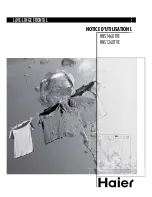
79
MNV4560
EN
Fig. 17
Drain hose connection
Connect the drain hose:
a) to the drain tube 40 mm in diameter with a vent,
b) or use the supplied adapter allowing drainage into a sink tub or a bathtub.
Note:
When used, the adapter must be fixed properly. Otherwise, it may come loose and water may spill on the
floor.
c) or use the siphon side hose of the sink or basin. Fix the hose to the lower side of the worktop. Thus, the water is
prevented from flowing back into the dishwasher.
The end of the drain hose should be 400-1000 mm (Figure 17) above the floor, and not immersed in water to
prevent water back flow.
Make sure the hose is not bent or jammed to prevent the water supply from becoming reduced or stopped.
Water inlet connection
• Prior to connecting the supply hose to the water mains, make sure the water pressure
complies with values of 0.04-1.00 MPa. In case of higher water pressure, a pressure
reduction valve must be installed.
• The dishwasher can be connected to hot (maximum 60°) or cold water. Connection to
cold water is recommended. A hot water supply may not necessarily be effective for very
stained dishes, as it reduces the time of the washing program too much.
• Connect the supply hose to a water tap with a 3/4” thread (Figure 22). Make sure the supply
hose is not bent, pressed, or tangled.
• When an old dishwasher is replaced with a new one,
a new water supply hose must
always be used
to connect to the water source; the old supply hose must never be reused.
• In case the water mains are new or were not used for a long time, let a sufficient volume of
water run out before connecting the water supply hose so that pipes may get flushed and
any potential deposits are prevented from entering the dishwater.
Fig. 18








































